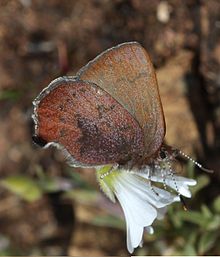- Callophrys augustinus
-
Callophrys augustinus 
Scientific classification Kingdom: Animalia Phylum: Arthropoda Class: Insecta Order: Lepidoptera Family: Lycaenidae Tribe: Eumaeini Genus: Callophrys Species: C. augustinus Binomial name Callophrys augustinus
(Westwood, 1852)[1]Synonyms - Incisalia augustinus (Westwood, 1852)
- Thecla augustinus Westwood, 1852
- Thecla augustus Kirby, 1837 (preocc. Fabricius, 1793)
- Deciduphagus augustinus
- Thecla iroides Boisduval, 1852
- Thecla iroides var. immaculata Cockle, 1910 (preocc. Fuchs, 1891)
- Incisalia iroides
The Brown Elfin (Callophrys augustinus) is butterfly of the Lycaenidae family. It is found in from Newfoundland north and west through the northern United States and the prairie provinces to Alaska. To the south it ranges in Appalachian Mountains to northern Georgia and northern [[Alabama, further south through the western mountains to northern Baja California.[2] Subspecies iroides is known as the Western Elfin.
The wingspan is 22–29 mm. Adults are on wing from early May to early June in one generation.[3] They feed on flower nectar from various species, including Vaccinium, Sanicula arctopoides, Lindera, Salix, Barbarea and Prunus americana.
The larvae feed on Ericaceae species, including Vaccinium vacillans and Ledum groenlandicum in the east. They feed on a wide variety of plants in the west, including Arbutus and Cuscuta species. They feed on the flowers and fruits of their host plant. Pupation takes place in the litter at the base of the host plant. Hibernation takes place in the pupal stage.
Subspecies
- Callophrys augustinus augustinus
- Callophrys augustinus helenae (dos Passos, 1943) (Newfoundland)
- Callophrys augustinus croesioides (Scudder, 1876)
- Callophrys augustinus iroides (Boisduval, 1852) (British Columbia to California)
- Callophrys augustinus annettae (dos Passos, 1943) (New Mexico)
- Callophrys augustinus concava Austin, 1998 (Nevada)
References
Categories:- Lycaenidae stubs
- Callophrys
- Butterflies and moths of North America
- Animals described in 1852
Wikimedia Foundation. 2010.
